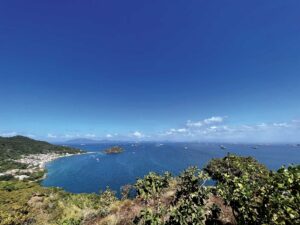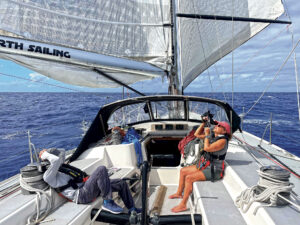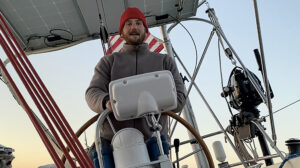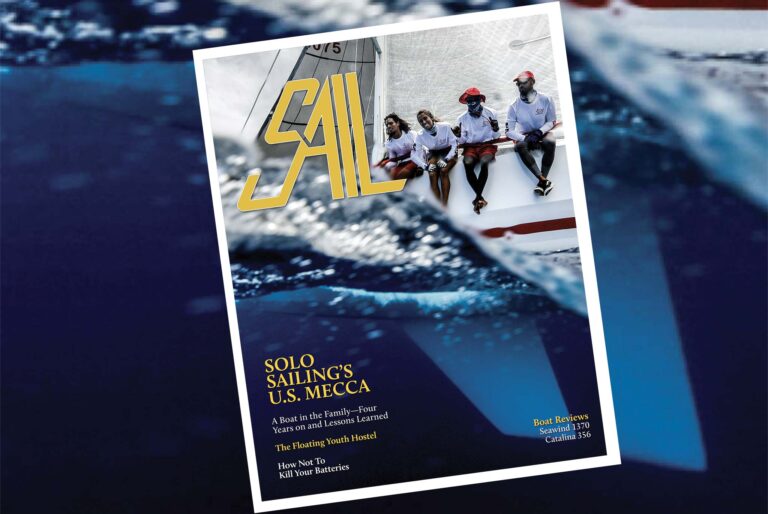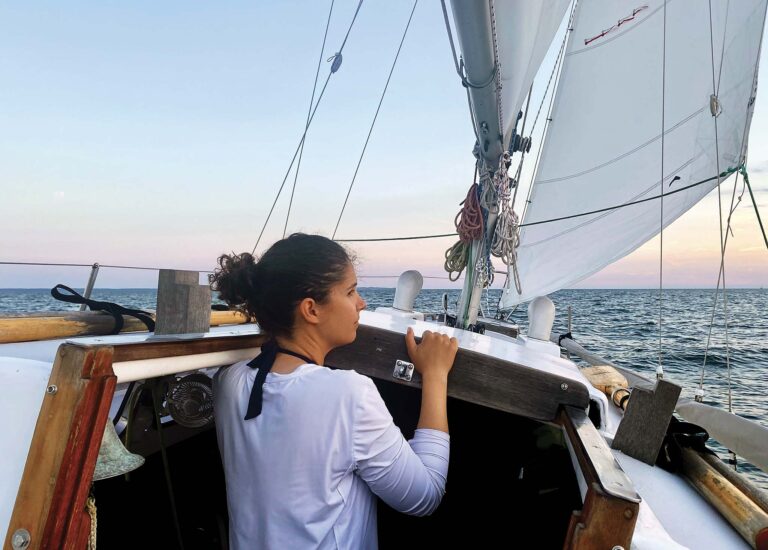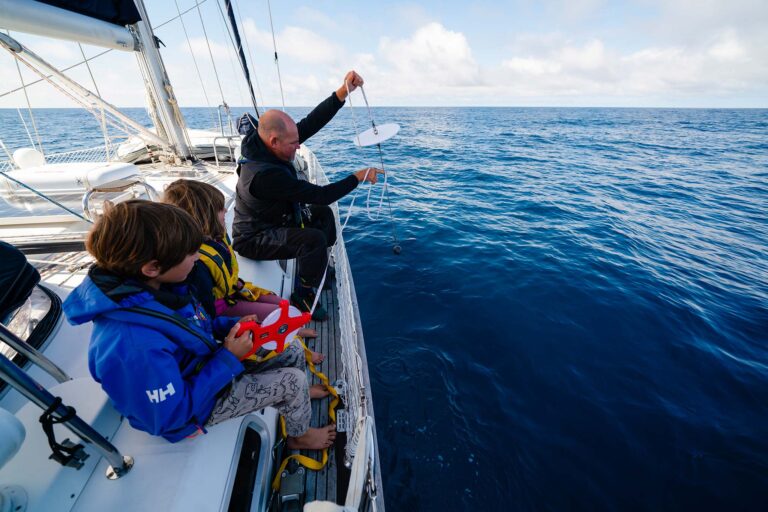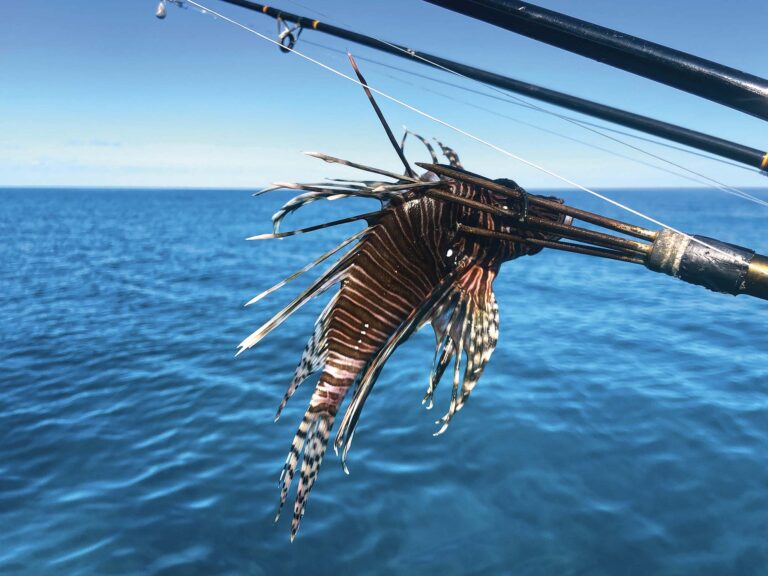
I sat on the bow of our pitching boat, 400 miles offshore in the Atlantic Ocean, looking up at the mess of carbon fiber and taffeta that was once a laminated headsail, thinking that this wasn’t part of the sailing dream brochure—nothing like this happened in the La Vagabonde or Delos YouTube videos I followed so passionately. But there was no way our journey was ending only a third of the way from St. Martin to the Azores. I had worked too long and hard to call it quits. Nor did I fancy turning west and motoring four days to Bermuda, my tail between my legs. It was time to get serious. One way or another, I was going to solve this problem.
As a former aircraft technician, I had hoped the preventative maintenance regime implemented on my yacht would hold me in good stead for our first ocean crossing. Our 1984 Moody 47, Ram, was a solid vessel with a reputation as a reliable bluewater cruiser; however, I had learned that boats were only as reliable as the owners who maintained them. Anchored in the Caribbean island of St. Martin, I had put in a solid two months of work, inspecting, repairing and replacing items I believed were necessary to a 2,500-mile voyage across the North Atlantic. Rigging and chainplate replacement, rudder rebuilding and steering cable alternatives kept me busy day and night. With a backup autopilot, second bilge pump and a good supply of spares, I had done my research and was prepared for almost anything—or so I thought.
With my wife, Erin, and our three children, Hamish, Jack and Christian, our plan was to travel east to the Azores. I had specifically chosen to skip Bermuda, hoping to avoid losing our momentum. However, I was acutely aware that this wasn’t a traditional tradewind route, and tales of sustained winds of 60 knots and huge seas haunted my dreams during the preparations.
Our departure from the Caribbean was just as I expected, a mad rush of work in the last week, frantically stowing, packing and provisioning, while watching to see if our weather window was going to remain open. As we weighed anchor on the planned day of departure, a feeling of panic washed over me. Were we actually doing this, particularly with only 18 months of sailing experience, and three kids onboard? I didn’t consider myself a reckless person, quite the opposite. But as I sailed out of Marigot Bay, I hoped I hadn’t bitten off more than I could chew.
The first few days of the passage went well. We settled into our roles of watchkeeping, cooking, cleaning and entertaining the children. Our seasickness was manageable, and the boat was behaving itself in near-perfect conditions. With 17 knots of wind out of the east, mild seas and the sun on our faces, we were making around 170 miles a day.
The route to the Azores was simple enough; head north-northeast to a point about 300 miles east of Bermuda, then turn east at latitude 38. By day five, we had made it past our turning point and were beginning to gain some easting. There were some significant squalls during the nights, but by using our radar, we managed to stay just ahead of them. One, in particular, chased us for a good two hours as we hurtled along in 25 knots of wind, all the while looking behind us as the night sky turned completely black and the radar screen completely red! It was quite an adrenaline rush.
We also encountered gear failures along the way—the generator not putting out AC power, deck plates leaking, batteries overheating, all of which had to be dealt with. However, the most serious problem we met was one I did not expect: our newly purchased, though admittedly secondhand, carbon-fiber headsail catastrophically delaminating 400 miles east of Bermuda.
It was on day five that I noticed the headsail had some small tears in it. I had never owned a carbon-fiber sail, but I had read about them prior to purchasing ours. The taffeta was beginning to peel away at the leech, about midway up the sail. The first time I noticed it, I wasn’t too concerned; it was only a small area, maybe the size of a dinner plate. What did concern me was the way the black carbon fiber strands inside the sail were moving around. It didn’t look normal, even to my untrained eye. Maybe I was in denial, but for whatever reason, I chose to ignore these first warning signs.
By the end of that day the delamination had worsened, and table-sized areas of taffeta were now flapping in the breeze. Stupidly, I didn’t bring the sail down, rationalizing the situation by saying, “What’s the worst that could happen?” After all, we were still sailing at 7 knots, and it was almost dark; best we wait till the morning. While I had done a lot of reading over the two years leading up to the crossing, getting my hands on as much information from magazines, websites, blogs and cruisers as to what could go wrong offshore, I had never heard of such a failure occurring. Perhaps this is why I didn’t immediately drop the sail, a rookie mistake that almost cost us the crossing.
Come sunrise, when I deemed it safe enough to finally drop the sail, the hole was the size of a mid-sized sedan. Our boat speed had fallen to below 3 knots, and we looked like a ghost ship sailing through the grey light that was now being infiltrated with the sun’s rays. Long threads of taffeta trailed behind us like spider webs. I suited up with lifejacket and tether, preparing to swap the sail out with our spare, but as I began to furl it away, a rather large bird’s nest of black carbon fiber became entangled around the foil. As the sail could only be dropped when completely unfurled, this posed a huge problem. I now couldn’t unfurl the sail to drop it, and we could no longer use the sail as it was flogging violently in the wind. My worries now turned to my rig—what if the flogging compromised that too?
It was no easy feat to remove the tangled, partly furled sail. With the sail completely destroyed, I wasn’t worried about any further damage I would inflict on it, but furling and unfurling, in an attempt to release the tangle, was only making the bird’s nest around the forestay larger and tighter. I initially tried to cut the mess away, desperately hoping this would allow the rest of the sail to unfurl. I zip-tied a boat hook, a gaff handle and a paddle together with a knife taped to the end, but my improvised 15ft pole-saw was no match for the incredibly strong carbon-fiber birds nest, and I just couldn’t get the leverage I needed to cut it away.
There had to be a way to get this sail down. We discussed going up the mast with a large knife, swinging out to the forestay in a bosun’s chair and then shimmying down the stay to cut the tangled area away. As keen as I was to figure this problem out, this option sounded just plain stupid and dangerous in that it had the potential to turn a bad situation into a life-threatening one. Another idea was to use our Gale Sail, a storm jib that clipped over the top of the furled headsail. However, while this small and extremely strong sail helped, it just wasn’t enough to get any real boat speed.
Plan C was to cut the sail from the bottom up. By filleting the furled sail just above the roller furler, and releasing the halyard, I was able to wrangle it down a foot at a time, making an incredible mess on deck. As I cut sections of the furled sail away, I was able to use the pitching of the boat to help me get some momentum to pull the sail slowly down the track. The little bump about 3ft up the foil, where the bolt rope fed into, was causing the remainder of the furled sail to get stuck, but once I realized this, I was able to cut above this area, and we were back in business—the business of cutting my headsail to shreds, that is.
In pitching seas and 20-knot winds, it took the better part of eight hours to complete the task. My arms were like jelly. I was coaxing every last ounce of energy from them, slicing chunks from the bottom of the sail, gathering the mess on deck into a sail bag and continually having to sharpen my knife as waves crashed over the bow. Finally, though, the sail was removed, and we hoisted a spare jib. A small portable knife sharpener turned out to be an essential tool that day—I was amazed at how quickly the knife blade would dull while cutting through all those layers of sail. It wasn’t something I had thought would be so vital during my passage planning, but now I wouldn’t go to sea without one.
As with anything worth doing, there are going to be challenges. Over the previous 18 months, my wife and I had gone from never owning a yacht to purchasing one sight unseen. We were so clueless at first that a friend had to help us move from the boatyard to a mooring ball. With a bit of persistence and a lot of mistakes, though, we have now found our feet and extensively cruised the Caribbean, all the while raising and homeschooling our three young boys, and finally, crossing the North Atlantic Ocean. The problems we encountered offshore all had solutions. They just took a bit of determination to figure out.
It was these same challenges that made our arrival into the Azores all the sweeter, and what made that possible was a never-give up-attitude. When you are in a situation that you cannot walk away from, even if you want to, it’s amazing what ideas present themselves. I believe anyone who tackles cruising with this mindset, is halfway there. There’s a lot to be said for the old saying ….try, try again.
Hailing from Australia, David Carey spent 12 years as an aircraft technician in the Royal Australian Air Force. He bought the family’s first boat, a Moody 47, in the Caribbean, cruised there for two years and recently crossed the Atlantic Ocean to the Azores.
January 2020

